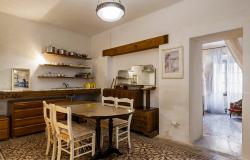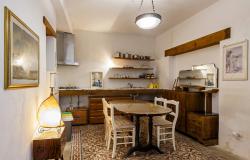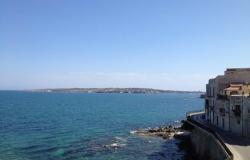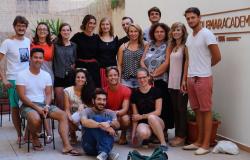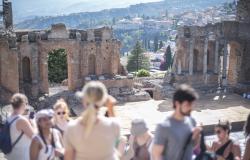Words and Pictures by Pat Eggleton
Good Friday is not a holiday in Italy so most of us go about our business much as usual on that day. If you are in Modica, “the city of one hundred churches”, however, you may feel a little uneasy during the morning , as if something is missing or not quite right, but you can’t put your finger on it. Then you remember: this day is not punctuated by the sound of church bells, for they fall silent on Thursday night and do not ring again until the morning of Easter Sunday, when great peals of joy sound throughout the city.
 Personally, I always feel that Easter begins on San Giuseppe’s Day on March 19th, for this saint is much loved in Sicily. In the Middle Ages he delivered the island from famine by bringing rain so a feast is prepared for him which, in some towns, includes altars of bread. The fava bean, too, is always part of San Giuseppe’s feast, for it was this vegetable which saved the Sicilians from starvation. Down in Modica Bassa there is a little niche which houses a lovely painting of San Giuseppe and I have only ever seen it open during the few days leading up to his feast day.
Personally, I always feel that Easter begins on San Giuseppe’s Day on March 19th, for this saint is much loved in Sicily. In the Middle Ages he delivered the island from famine by bringing rain so a feast is prepared for him which, in some towns, includes altars of bread. The fava bean, too, is always part of San Giuseppe’s feast, for it was this vegetable which saved the Sicilians from starvation. Down in Modica Bassa there is a little niche which houses a lovely painting of San Giuseppe and I have only ever seen it open during the few days leading up to his feast day.
 Then there is Palm Sunday and I love to watch people walking to church carrying palms of all sizes, formed into crosses or intricate braids. In my street a lady sits at the roadside every day during the week before Palm Sunday, making these from dawn till dusk.
Then there is Palm Sunday and I love to watch people walking to church carrying palms of all sizes, formed into crosses or intricate braids. In my street a lady sits at the roadside every day during the week before Palm Sunday, making these from dawn till dusk.
 On Easter Saturday there is frantic activity in all the kitchens of Modica, for everyone has their “tuma” of ricotta ready to make cassate. A “tuma” is made of the cheese which falls to the bottom of the pan when Sicilians make ricotta. It traditionally comes in special wicker containers but more often comes in plastic ones now. This Easter pastry is not the coloured ice cream cake “cassata” that you may have seen but is made to a much older, simpler recipe which Katia gives us here.
On Easter Saturday there is frantic activity in all the kitchens of Modica, for everyone has their “tuma” of ricotta ready to make cassate. A “tuma” is made of the cheese which falls to the bottom of the pan when Sicilians make ricotta. It traditionally comes in special wicker containers but more often comes in plastic ones now. This Easter pastry is not the coloured ice cream cake “cassata” that you may have seen but is made to a much older, simpler recipe which Katia gives us here.
 It is Easter Sunday at last and the feasting begins after Mass: there is pasta of course, a main dish of lamb for most households and perhaps some chicken as well. Afterwards there is fruit, there are the “colombe” [dove-shaped cakes] and desserts that friends and relatives have brought along and at last, the cassate.
It is Easter Sunday at last and the feasting begins after Mass: there is pasta of course, a main dish of lamb for most households and perhaps some chicken as well. Afterwards there is fruit, there are the “colombe” [dove-shaped cakes] and desserts that friends and relatives have brought along and at last, the cassate.
 But the real culinary stars of the Easter season are artichokes, which are so plentiful at this time that you can buy them by the crate at the roadside. They are traditionally grilled for the Pasquetta [Easter Monday] feast – yes, there is another one! – and we just suck the wonderful juices and then discard the leaves. This makes for very messy but very jolly eating! The artichokes are usually served before the main course but sometimes they appear again after the desserts – which is no stranger than the British habit of serving celery with cheese before the coffee – and surprisingly, they clear the palate.
But the real culinary stars of the Easter season are artichokes, which are so plentiful at this time that you can buy them by the crate at the roadside. They are traditionally grilled for the Pasquetta [Easter Monday] feast – yes, there is another one! – and we just suck the wonderful juices and then discard the leaves. This makes for very messy but very jolly eating! The artichokes are usually served before the main course but sometimes they appear again after the desserts – which is no stranger than the British habit of serving celery with cheese before the coffee – and surprisingly, they clear the palate.
 I nearly forgot to tell you about the other pastries, without which no Sicilian celebration can be complete: In the days leading up to Easter the bars offer “affogapreti” or “affucaparrini” in dialect [“priest-drowners”].
I nearly forgot to tell you about the other pastries, without which no Sicilian celebration can be complete: In the days leading up to Easter the bars offer “affogapreti” or “affucaparrini” in dialect [“priest-drowners”].
Last Saturday my hairdresser offered these pretty pastries in his salon:
And of course there are Easter eggs and concoctions made from our wonderful Modican chocolate. I’m just going to enjoy it all and go on that diet after Easter!
Buona Pasqua a tutti from Simi the dog and me.



